A world with no males - reality is stranger than fiction.
I want to have the talk with you. A male and a female have sex, an egg is fertilized and that is where babies come from. You with me so far? Okay, now throw that out the window :)
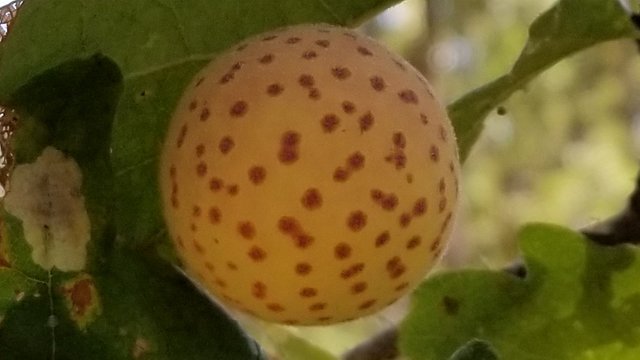
I want to have another talk with you. There are no males. There is no sex. An unfertilized egg develops into an embryo and that is where babies come from. And that is parthenogenesis, ladies and gentlemen.
But why stop there? Let's have both talks at once. Plus can we have super powers that allow us to control plants?
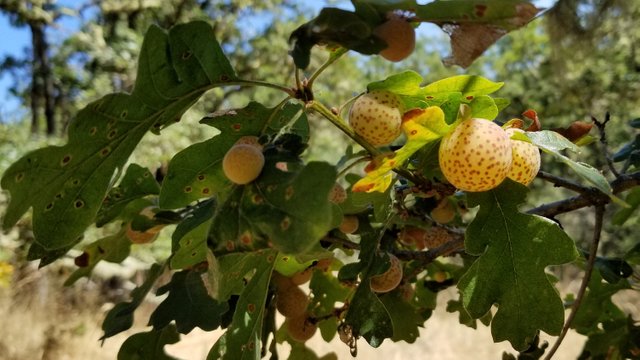
Oak gall wasps alternate between generations of parthenogenic females, and generations of sexually reproducing males & females. The male/female sexual generation emerges in mid to late summer from galls on the underside of oak leaves. These galls are colorful orange-ish yellow balls with darker orange-brown mottling. These galls are actually quite visually striking and the first time I encountered them I couldn't figure out what was going on!
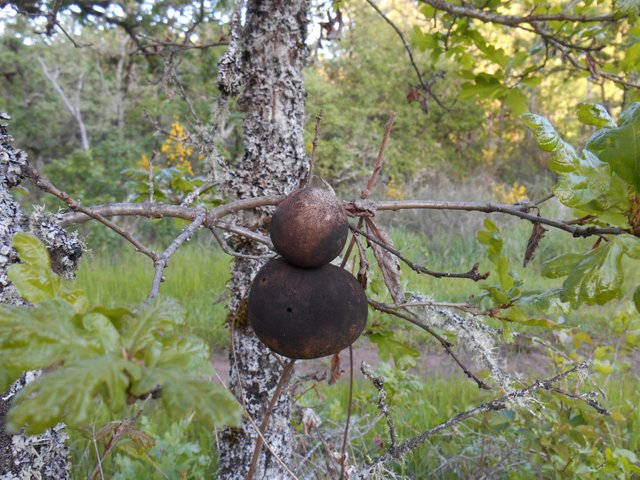
The mated females from this sexual generation lay their eggs in twigs of the oak tree. These eggs develop into an all-female parthenogenic generation. The larvae somehow (exact mechanism not fully understood) force the oak tree to grow a large woody gall, often called an "oak apple", which serves as the home for the larvae overwinter. In the spring the mature parthenogenic females burrow out of the galls and lay their eggs on the underside of oak leaves.
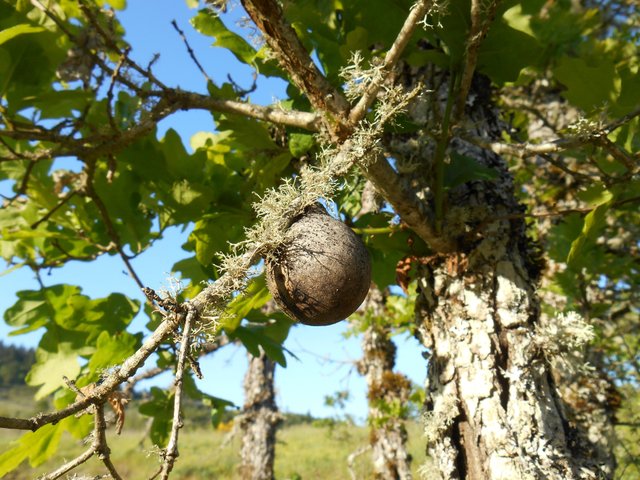
"Oak Apple" (woody gall)
The eggs laid by the parthenogenic females develop into a new sexual generation of males and females. The larval form of the sexual generation somehow (exact mechanism unknown) causes the leaf of the oak tree to grow spotted orange galls for the larvae to live in while maturing, before they exit mid to late summer to start the cycle over again :)
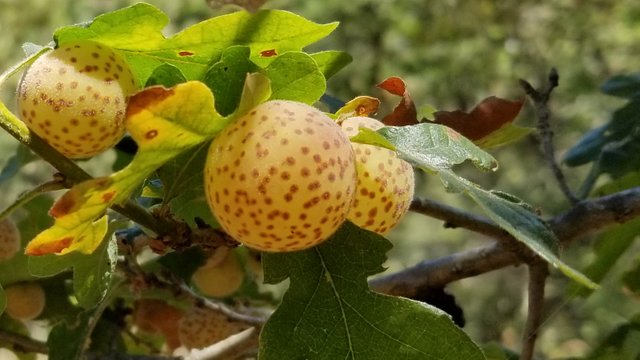
Okay but everyone, this is real life so of course it gets even crazier. Right? There are parasitoid wasps that stick their long ovipositors straight into the gall and lay their own eggs inside or on the larvae of the gall wasps. The parasitic wasp larvae eat the gall wasp larvae and take over the gall.

Parasitoid wasp species - I believe this particular one actually lays its eggs on caterpillars. Note it does not have a long ovipositor that would allow it to lay eggs inside of galls.
Actual gall wasps are quite small (1 - 8 mm) and non-threatening looking (they cannot sting). However the first time I broke open a leaf gall to see what was inside I encountered one of the parasitoid wasp larva, almost fully mature - it was big and scary as hell! Most of the parasitoids around here are shiny black crazy looking wasps.
And of course, let's not forget the hyperparasitical wasps which specifically parasitize the parasitoid wasps! Yes that is right, the hyperparasitical wasps lay their eggs inside the larvae of the parasitoid wasps, inside the galls made by the gall wasps.
Oh you thought we were done? There are other species of wasps that sort of crash the party and lay their eggs inside the galls produced by other wasps, but which are not parasitic. These species are inquilines of the gall wasps - their larvae coexist with the gall wasp larvae inside the gall without harming them. As it turns out, this sort of thing is actually pretty common among ants as well, where a dozen or more species of inquilines may share a colony dug by another species!
Oh and by the way there are tons of different species of gall wasps and they all target different types of plants and tissues and produce different types of galls. Here is a really beautiful wasp-induced gall I found on a rose bush once <3
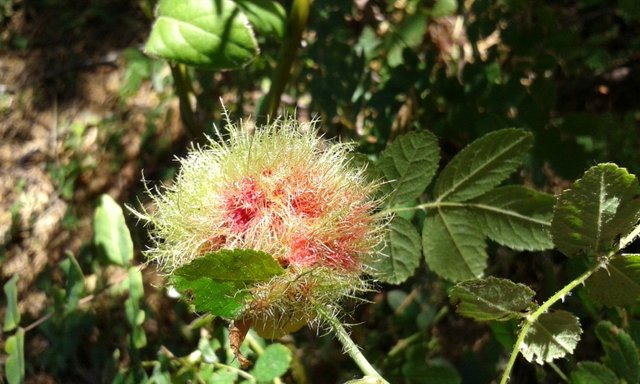
Wasp on the Water
I filmed this short clip on the Middle Fork of the Willamette River on the flanks of Mount Pisgah a few days ago. Just a stones throw from where I took the pictures of the oak galls, although this is not a gall wasp nor a parasitic wasp. The shores of the river were swarming with these wasps, who thankfully left us alone :) My original guitar music accompanying the video
.
Mount Pisgah Rocks!
I have already extolled the virtues of Mount Pisgah here, and our recent family hike was another awesome string in the bow.
Learn more about oak galls
Oak Galls - Oregon Department of Forestry 2017
A Field Guide to Insects and Diseases of California Oaks - TJ Swiecki 2006
aaaaah these parasitic wasps ! i saw a documentary about them once and they are super fascinating.... kinda scary, too, but awesome as well XD
this kind of stuff absolutely fascinates me
omg, as i was reading this, i was somwhat horrified, yet, i couldnt stop reading :P
Great post
Haha you are right. Those don't look too scary. We have tarantula hawks here and it is super unnerving when they are flying around near you even if they don't sting often.
That is a pretty trippy weird cycle for sure. The one that trips me out is that fungus that infects ants and does something to their brain or whatever and drives them to climb up on leaves and wait until new fungus bursts out of their bodies like the freaking zenomorph from Alien or something.
ermagerd yes I absolutely love cordyceps fungus - btw cordyceps doesn't just go after ants, there are thousands of different varieties of cordyceps fungus each one specialized for a single species of insect host. All kinds of insects! This actually reminds me of a work of art I have in progress unfinished, I started doing a digital piece of what it would look like if cordyceps went after humans :) <3
Haha nice. It is like the mushrooms revenge lol.
The computer game the last of us did refeer to that. Their artwork is kinda cool.
Oh cool I will check that out! :)
Oak apples are nuts!
Who knew.
Keep those pollinators alive!
unless they don't actually pollinate. Then forget I said that...
Oak gall wasps don't pollinate in their gall making activities at least, although another famous gall wasp does pollinate figs in a very bizarre way. A fig is crazy, the flowers are totally enclosed in a structure called the syconium, so when a fig flowers the flowers are actually not exposed to the air at all. They are 100% dependent on gall wasps for pollination, the gall wasps lay their eggs inside the syconium and when the mature wasps are ready to leave the syconium they carry with them the pollen from the flowers inside the syconium they grew up in, and they take that pollen with them as they seek out a new fig syconium to burrow inside of (pollinating that one in the process).
Hey @carlgnash
Here's a tip for your valuable feedback! @Utopian-io loves and incentivises informative comments.
Contributing on Utopian
Learn how to contribute on our website.
Want to chat? Join us on Discord https://discord.gg/h52nFrV.
Vote for Utopian Witness!
Hey cool, thanks @utopian-io! I love it that you support good commenting :) Keep up the great work! Much love - Carl
Interesante post, me asusta soy alérgica si me pican tengo que ir corriendo al medico, ten cuidado
This post was shared in the Curation Collective Discord community for curators, and upvoted and resteemed by the @c-squared community account after manual review.
Oh my goodness! So thats what you are up to in your free time? Hyper parasitic wasp voyeurism!
Nature is the best; I could have taken a few more 'mechanism unknown' clauses, but this is still 100% awesome!
Yes nature is truly the best :)
Awful and yet so amazing, fun and cause some strange delight. Nature continues its development. It is very interesting what the world will be like in thousands of years.
Yes and the awesome thing about insects is that their generations are so short (often multiple generations per year) that evolution happens at a much faster pace compared with longer lived / slower reproducing animals. The complex webs of interdependencies that have evolved between insect species are so interesting!
Super trippy the intricacies of this life! Awesome article all this is news to me! I thought wasps made nest 🙈 haha, the thing that you learn each day. Now, your friends comment about the fungus and the ants 😲 .... that sounds like scenes from a horror film! Thank-goodness for your beautiful guitar music which accompanied your video. Haha, i am going to vote for more of that and less of this creepy talk about these bugs lives!
well I have a pretty diverse blog LOL So stay tuned for more tunes. But also, more bugs as well.